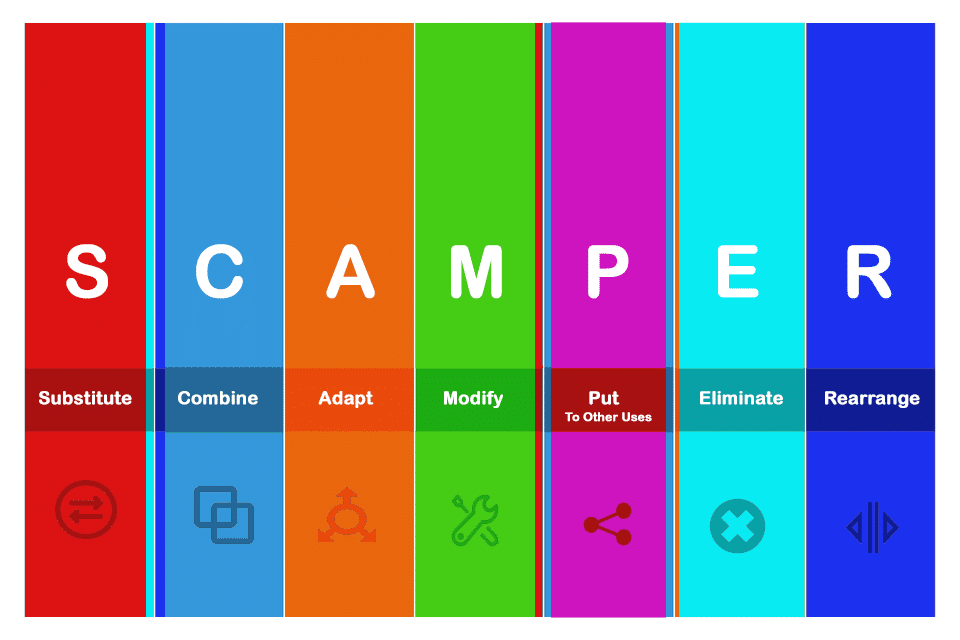What is SCAMPER?
Smartpedia: SCAMPER is a creativity method that uses a series of keywords and questions to facilitate the search for ideas.
SCAMPER – idea search based on keywords
The enhancement of products and services, of concepts, processes or ideas is an important competitive factor for many companies. SCAMPER or the SCAMPER method helps here. It was developed by Robert F. Eberle to promote the creative imagination of children.¹ Due to its universal applicability, the method quickly gained a foothold in numerous companies worldwide.
SCAMPER is an acronym:
- S – Substitute
- C – Combine
- A – Adapt
- M – Modify
- P – Put To Other Uses
- E – Eliminate
- R – Rearrange
SCAMPER was trialled in the early 1970s on children from the age of three to university students and teachers. Apart from its intended use in the lower age groups, the technique was found to be applicable to people of all ages and in a variety of situations and helped to
- positively promote group dynamics,
- arouse curiosity,
- stimulate engagement, and
- develop strategies for creative listening and imagination development.²
As a method, SCAMPER is comparable to the Osborn Checklist by Alex F. Osborn. Osborn is also considered the inventor of brainstorming.
SCAMPER – examples of the method
Questions arise from the keywords in the concrete application. Below you will find some examples:
- Substitute is about replacing parts of a product, service or idea. People or partners involved could also be substituted.
Questions: Which components can be replaced? What alternative materials can be used. Which products can be replaced by our product? Or what other product could be substituted by our product? And what alternative distributors can help us sell our products?
Examples: A combustion engine in a car or motorbike is replaced by an electric motor. A customer magazine is replaced by a monthly newsletter. Supplier B replaces supplier A. - Combine is about combining ideas, products or services in whole or in part. It is about integrating functions or overlapping services.
Questions: What other products would be useful to increase the benefit of our product? Which components can be recombined with each other? Which people can collaborate to move the project forward?
Examples: Social media posts can be automated to play out on websites. TV sets need external speakers that are connected via WLAN. A radio alarm clock that plays music instead of an alarm tone. - Adapt is about adapting solutions, products or ideas to situations or needs. It is about changing the context and varying components in order to address other application scenarios or target audiences.
- Questions: How can the application purpose be expanded? What features does the product need to be more useful?
Examples: The interface of an app can be changed to night mode. Instead of a FAQ list on a website, a chatbot is used that begins to communicate with customers based on the answers in the FAQ list. - Modify is about changing features, expanding a feature set, redesigning pricing models, or transforming colour, shape, size, etc.
Questions: Which aspects help to increase the user experience? How can our service have even more impact? How can the conversion rate on our website be increased?
Examples: Cars get facelifts, i.e. the bodywork changes in parts, but the major part of the car remains unchanged. Mobile phones come onto the market in gold and with a changed pricing strategy and become status objects in demand. - Put To Other Uses is about the question of whether the product or service is also suitable for other areas of application or new markets.
Questions: Are there markets, industries, customer groups or professional groups that could also use our product? How would the service work in a different environment? How can individual components be used elsewhere?
Examples: Mustard is sold in jars that later function as drinking glasses. Chilli is not only used to flavour meat dishes, but also as an ingredient in chocolate. High-visibility waistcoats are not only used in emergencies, but also by cyclists. - Eliminate is about reducing functions, omitting elements or components, or making product or service features simpler.
Questions: How can our product be marketed more easily? Which functions are hardly used? How can the operation of our product be improved?
Examples: Voice recognition instead of keyboard input for search queries on the internet. Designing products for regular and professional use. Reduction of price options for products. Voluntarily restricting health insurance benefits in exchange for lower health insurance premiums. Or removing CD drives from laptops and storing or retrieving data from the cloud. - Rearrange is about a different interaction of individual elements of a solution, about changing work steps or the organisation of a service.
Questions: How can I optimise our workflow through a different work arrangement? Which services can increase the trust of potential customers? How can we make our product more environmentally friendly without a major change in production?
Examples: Customers pay via external service providers in webshops who are liable in case of problems. Yoghurt manufacturers offer the possibility to separate the product band from the cup and recycle it as waste paper. In series production, instead of 9 steps at one workstation, only 8 steps are needed. Drive-in counters enable shopping without leaving the car. Fast food chains ask their customers to dispose of leftovers themselves, thus ensuring clean tables.
Tips for using the SCAMPER method
There are some tips on how to use SCAMPER:
- The method is an alternative to classic brainstorming and offers a structured approach to finding ideas, improvements or innovations through the use of keywords. Therefore, the brainstorming rules should also apply.
- It may make sense to focus on individual keywords and schedule several meetings.
- It may be useful to agree on a specific goal. Example: We want to find an idea for which additional target audience our product is suitable. And then we want to consider which steps are necessary to address this target audience.
And last but not least: The follow-up of a SCAMPER session is very important. Collecting and evaluating ideas is often relatively easy, but the concrete implementation of proposals generates a lot of effort. Here it is important to work consistently on implementation and to communicate accordingly with the participants of the session. SCAMPER is not an end in itself; it only makes sense to use it for future issues if the method yields concrete advantages.
Impulse to discuss
How important is it for successful product or service development to master several creativity techniques?
Notes:
[1] [2] Scamper: Creative Games and Activities for Imagination Development.
Various publications mention 1996 or 97 rather than 1972 as the date of invention. This is probably because SCAMPER Creative Games and Activities For Imagination Development was published in the mid-90s.
Sometimes we also read of SCAMPERR (with two R’s). Rearrange is joined by Reverse. Instead of Put To Other Use, Purpose is sometimes used. And sometimes the keyword Magnify is used instead of Modify. However, this raises the immediate question of why the Minify of the Osborn checklist is not also mentioned.
Here you can find a German video on the SCAMPER-Methode.
Here you can download a SCAMPER template.
Here you can download the Ideation Whitepaper free of charge. It explains many more practical methods of idea generation in detail.
If you like the article or would like to discuss it, please feel free to share it in your network. And if you have any comments, please do not hesitate to send us a message.
And here you will find additional information from the t2informatik Blog:



